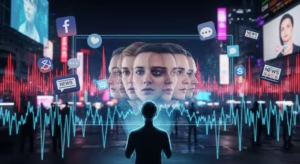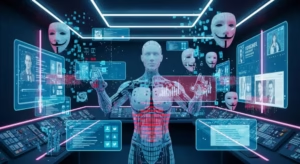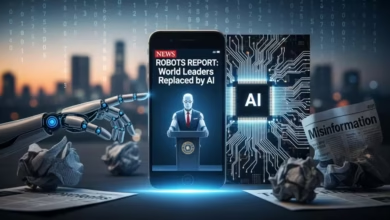The Dark Side of AI: Deepfakes, Misinformation, and Digital Trust

This blog post explores the darker implications of AI and deepfakes on society, examining how these technologies contribute to misinformation and erode digital trust. It discusses the significant impact of AI-driven deepfakes on communication, detailing the ways in which they can manipulate perceptions and spread false information. The article highlights vital strategies for identifying and detecting deepfakes effectively, emphasizing the importance of technological advancements in this area. Furthermore, it outlines actions individuals and organizations can take to foster digital trust amidst the growing prevalence of deepfake content. By understanding the nuances of AI and deepfakes, readers are better equipped to navigate the complexities of digital communication in today’s landscape.
Understanding The Impact Of AI And Deepfakes On Society

As technology continues to evolve, the emergence of AI and deepfakes raises significant implications for societal trust and ethics. The ability of AI to create hyper-realistic images and videos poses a threat not only to personal reputations but also to institutions and democratic processes. As these technologies become more accessible, the potential for misuse increases exponentially, leading to a landscape rife with misinformation.
Key Concerns Related To AI And Deepfakes
- Manipulation of public figures and misinformation dissemination
- Erosion of trust in media and information sources
- Challenges in attributing accountability for harmful content
- Impacts on personal privacy and consent
- Potential for exploitation in political campaigns
- Threats to national security through disinformation
- Legal and regulatory hurdles in enforcement
The implications of these concerns extend into the realm of digital ethics, prompting urgent discussions about how we can safeguard truth in the digital age. As AI and deepfakes proliferate, we must consider the moral responsibilities of developers and users alike. This leads us to examine existing frameworks and the necessity for establishing robust ethical guidelines that can govern the use of AI technologies.
Moreover, as society grapples with the reality of deepfakes, educating the public on recognizing AI-generated content becomes paramount. Awareness campaigns and educational tools can empower individuals to discern between genuine and fabricated media. Through a collective effort to promote media literacy, we can bolster resilience against the ill effects of AI and deepfakes while fostering a healthier digital environment.
Analyzing The Role Of AI Misinformation In Digital Communication

AI misinformation has emerged as a significant challenge in digital communication, especially with the rise of synthetic media. These innovations have allowed the creation of deepfakes, where realistic-looking videos or audio recordings can present information that may not be true. This capability poses a substantial risk to the integrity of information shared digitally, leading to confusion and mistrust among audiences. When AI-generated content is produced without proper verification, it can easily mislead individuals, create false narratives, and shape public opinion based on fictitious premises.
The proliferation of AI misinformation can be tracked through various forms of digital content. From fake interviews to manipulated news clips, the impact of fake media on communication is profound. The acceptance of synthetic media as a legitimate source of information can distort perceptions, especially when used in political or social contexts. As digital consumers become increasingly exposed to such misleading content, the importance of understanding how to critique and verify the authenticity of what they encounter becomes paramount.
| Type of AI Misinformation | Description | Impact Level |
|---|---|---|
| Deepfakes | Customized video and audio that can portray someone saying or doing things they never did. | High |
| Fake News Articles | Articles that are created to mislead readers with false information. | Medium |
| Manipulated Images | Images that have been altered to present a false reality. | Medium |
| Misrepresented Data | Statistics or research findings that are misused to support a specific agenda. | Low |
As we delve deeper into understanding the ramifications of AI misinformation, it is essential to recognize the consequences that arise from the misuse of synthetic media. Not only does it undermine trust in digital platforms, but it also places undue stress on democratic processes and societal norms. By spreading false information, the detrimental effects can manifest in economic fluctuations, reputational damage for individuals or organizations, and even affect mental health as individuals grapple with the overload of contradictory information. Societies may find it challenging to navigate through authentic content, resulting in polarization and anxiety.
Steps To Identify AI Misinformation
- Verify the source of the information to check if it is credible.
- Look for corroborative evidence from multiple reputable sources.
- Analyze the content for any signs of manipulation or editing.
- Consider the intention behind the message or who benefits from its dissemination.
- Engage with fact-checking websites to cross-reference claims.
- Be skeptical of sensational headlines that may skew the truth.
- Educate yourself about common tactics used in misinformation.
Understanding how to identify AI misinformation is crucial for maintaining digital integrity. Individuals must cultivate a healthy skepticism about the media they consume. The modern digital landscape requires active participants who not only consume content but also question and validate it. A heightened awareness of the capabilities and limitations of synthetic media empowers users to make informed decisions about the information they share and engage with online.
Examples Of AI Misinformation
Numerous high-profile cases of AI misinformation highlight its impact on society. The emergence of deepfakes has led to instances where political figures were depicted saying or doing things that were fabricated, significantly influencing public perception and opinion. An example includes a manipulated video of a public official that went viral, creating widespread confusion and leading to public unrest. Recognizing these examples emphasizes the need for vigilance among consumers of digital content.
Consequences Of Misinformation
The consequences of AI misinformation are troubling, as they can erode public trust and lead to significant societal discord. Misinformation can incite fear, promote conspiracy theories, and ultimately undermine the democratic process. As people struggle to separate truth from fiction, the ability to engage in informed discourse diminishes, leaving room for divisive rhetoric and polarization. Addressing AI misinformation calls for a collective effort from technologists, educators, and policymakers to foster a digital environment rooted in trust and integrity.
Strategies For Effective Deepfake Detection Techniques

Deepfake technology is advancing rapidly, making it increasingly crucial to implement effective deepfake detection techniques. The implications of deepfakes extend beyond mere entertainment; they pose significant threats to digital ethics, societal trust, and political discourse. To combat these risks, various strategies combining technological and human measures must be employed. The effective detection of deepfakes requires continual innovation and adaptation to stay ahead of the malicious uses of this technology.
The first step towards effective deepfake detection is leveraging cutting-edge technological approaches. Various AI algorithms designed to analyze audiovisual content can help identify inconsistencies typically present in deepfakes. Machine learning models can be trained on vast datasets of genuine and forged content, enhancing their ability to detect anomalies. However, as deepfake creation techniques evolve, detection tools must also improve, necessitating a continuous cycle of innovation and training.
Technological Approaches
Employing sophisticated algorithms is essential for identifying deepfakes. Various techniques include:
| Technique | Description | Effectiveness |
|---|---|---|
| Facial Recognition | Identifies facial inconsistencies and mismatches. | High |
| Audio Analysis | Detects unnatural voice patterns and speech characteristics. | Medium |
| Pixel-Level Analysis | Examines pixel-level inconsistencies often found in edited footage. | High |
| Temporal Analysis | Detects irregularities in frame rate and continuity. | Medium |
While technology plays a crucial role in deepfake detection, human oversight is equally essential. Trained professionals can utilize their cognitive skills to assess content critically, noticing subtle cues that AI might overlook. This human touch is significant in high-stakes scenarios where misinformation can lead to considerable public harm or political unrest.
Human Oversight
Training individuals in digital forensics and media literacy can help combat the consequences of deepfakes. Encouraging the general public to develop critical thinking skills when consuming media is paramount. By fostering an understanding of digital ethics, society can become more resilient against misinformation. Additionally, establishing frameworks for accountability and transparency can further enhance human involvement in detection efforts.
Emerging Solutions
In response to the escalating threat posed by deepfakes, new solutions are emerging. Collaborations between tech companies, academic institutions, and governments are pivotal in developing more sophisticated detection tools. Innovations such as blockchain technology, which ensures the verification of the authenticity of digital content, hold promise in establishing trust in digital media. These approaches can complement traditional detection methods and provide a broader safety net against deepfake misinformation.
Comparison Of Deepfake Detection Tools
- Deepware Scanner – Specializes in real-time deepfake detection for videos.
- Sensity AI – Focuses on large-scale deepfake identification and analysis.
- Amber Video – Employs AI algorithms to verify authenticity in media.
- Deeptrace – Offers comprehensive solutions combining tech and forensics.
- Reality Defender – Protects against deepfakes across various platforms.
- Serelay – Provides tools for provenance tracking of images and videos.
- Microsoft Video Authenticator – Assesses the integrity of video content.
Taking Action: Building Digital Trust In The Age Of Deepfakes

As we delve deeper into the age of AI and deepfakes, it becomes imperative to address the urgent need for building digital trust. The proliferation of synthetic media has raised significant concerns regarding authenticity and reliability in online communication. People increasingly rely on digital platforms for news and social interactions, yet the blurring of reality introduced by deepfakes puts the integrity of information at risk, creating a critical challenge for societies worldwide.
To effectively combat the negative implications of AI and deepfakes, stakeholders—ranging from tech companies to individual users—must collaborate on fostering an environment that prioritizes truthfulness. This can be achieved through education, technological advancements, and regulatory frameworks that encourage responsible usage of synthetic media. Transparency about the source and purpose of content will be essential in regaining public confidence in digital platforms.
Practical Steps To Foster Digital Trust
- Enhance digital literacy programs for the public to discern between genuine content and deepfakes.
- Implement advanced detection technologies that identify manipulated media before they spread.
- Encourage content creators to disclose the use of synthetic media in their works.
- Promote collaboration between tech companies, governments, and NGOs to develop ethical guidelines.
- Develop public awareness campaigns about the risks associated with deepfakes.
- Utilize blockchain technology for verifying the authenticity of critical information.
Ultimately, the fight against misinformation through AI and deepfakes hinges on our collective commitment to uphold and nurture digital trust. By implementing these practical steps, society can aspire to create a resilient ecosystem that values truth while embracing technological innovation. The path forward may be challenging, but the integration of trust-building measures is essential in safeguarding our digital world.
Briefing Document: The Dark Side of AI: Deepfakes, Misinformation, and Digital Trust
I. Executive Summary
This briefing document summarizes key themes and critical facts from the provided source, “The Dark Side of AI: Deepfakes, Misinformation, and Digital Trust – The Future of Artificial Intelligence.” The document highlights the escalating threat posed by AI-driven deepfakes and synthetic media, their profound impact on societal trust, communication, and democratic processes, and outlines strategies for detection and fostering digital trust. The core message emphasizes the urgent need for a multi-faceted approach involving technological advancements, human oversight, education, and regulatory frameworks to combat misinformation and safeguard digital integrity.
II. Main Themes and Most Important Ideas
A. The Pervasive Threat of AI and Deepfakes
The source consistently emphasizes the significant and growing threat posed by AI-generated deepfakes. It states that “The ability of AI to create hyper-realistic images and videos poses a threat not only to personal reputations but also to institutions and democratic processes.” As these technologies become more accessible, the “potential for misuse increases exponentially, leading to a landscape rife with misinformation.”
Key Concerns Related to AI and Deepfakes:
- Manipulation of public figures and misinformation dissemination: Deepfakes can fabricate scenarios where individuals appear to say or do things they never did, influencing public perception.
- Erosion of trust in media and information sources: The widespread presence of fabricated content makes it difficult for audiences to discern truth from fiction.
- Challenges in attributing accountability for harmful content: Determining the origin and responsibility for harmful deepfake content is complex.
- Impacts on personal privacy and consent: Deepfakes can violate privacy and exploit individuals without their consent.
- Potential for exploitation in political campaigns: Manipulated content can sway elections and undermine political discourse.
- Threats to national security through disinformation: State-sponsored deepfakes could be used for geopolitical manipulation.
- Legal and regulatory hurdles in enforcement: Existing legal frameworks struggle to keep pace with the rapid evolution of deepfake technology.
B. The Role and Consequences of AI Misinformation in Digital Communication
AI misinformation, particularly through synthetic media like deepfakes, “has emerged as a significant challenge in digital communication.” The source notes that “realistic-looking videos or audio recordings can present information that may not be true,” leading to “confusion and mistrust among audiences.”
Types of AI Misinformation and their Impact:
- Deepfakes: “Customized video and audio that can portray someone saying or doing things they never did.” (High impact)
- Fake News Articles: “Articles that are created to mislead readers with false information.” (Medium impact)
- Manipulated Images: “Images that have been altered to present a false reality.” (Medium impact)
- Misrepresented Data: “Statistics or research findings that are misused to support a specific agenda.” (Low impact)
The consequences of this proliferation are severe:
- Undermining trust in digital platforms.
- Placing “undue stress on democratic processes and societal norms.”
- Manifesting in “economic fluctuations, reputational damage for individuals or organizations, and even affect mental health.”
- Leading to “polarization and anxiety” as societies struggle to navigate authentic content.
C. Strategies for Effective Deepfake Detection
Combating deepfakes requires a combination of “technological and human measures.” The source emphasizes that “effective detection of deepfakes requires continual innovation and adaptation.”
1. Technological Approaches:
- Sophisticated Algorithms: AI algorithms trained on vast datasets of genuine and forged content can identify inconsistencies.
- Specific Techniques:Facial Recognition: Identifies facial inconsistencies and mismatches (High effectiveness).
- Audio Analysis: Detects unnatural voice patterns and speech characteristics (Medium effectiveness).
- Pixel-Level Analysis: Examines pixel-level inconsistencies often found in edited footage (High effectiveness).
- Temporal Analysis: Detects irregularities in frame rate and continuity (Medium effectiveness).
2. Human Oversight:
- Critical Assessment: “Trained professionals can utilize their cognitive skills to assess content critically, noticing subtle cues that AI might overlook.”
- Digital Forensics and Media Literacy: Training individuals in these areas is crucial.
- Critical Thinking: Encouraging the general public to develop critical thinking skills when consuming media is “paramount.”
3. Emerging Solutions:
- Collaboration: Partnerships between “tech companies, academic institutions, and governments” are vital.
- Blockchain Technology: Holds promise for “verification of the authenticity of digital content.”
- Specialized Tools: Examples include Deepware Scanner, Sensity AI, Amber Video, Deeptrace, Reality Defender, Serelay, and Microsoft Video Authenticator.
D. Building Digital Trust in the Age of Deepfakes
The source concludes by stressing the “urgent need for building digital trust” in an age where the “blurring of reality introduced by deepfakes puts the integrity of information at risk.”
Practical Steps to Foster Digital Trust:
- Enhance digital literacy programs: Educate the public to discern genuine content from deepfakes.
- Implement advanced detection technologies: Identify manipulated media before it spreads.
- Encourage content creators to disclose synthetic media use: Promote transparency.
- Promote collaboration: Develop ethical guidelines through partnerships among tech companies, governments, and NGOs.
- Develop public awareness campaigns: Inform about deepfake risks.
- Utilize blockchain technology: Verify the authenticity of critical information.
The fight against misinformation “hinges on our collective commitment to uphold and nurture digital trust.”
The rise of AI and deepfakes presents an unprecedented challenge to digital integrity and societal trust. The ability to generate hyper-realistic fabricated content threatens personal reputations, democratic processes, and national security. Combating this threat requires a dynamic and multi-layered strategy that integrates cutting-edge technological detection methods with robust human oversight and critical thinking. Crucially, fostering digital trust through widespread digital literacy, transparency, and collaborative ethical frameworks is paramount to navigating the complexities of the evolving digital landscape and safeguarding the truth.
Homepage / humanaifuture.com
For similar articles, please visit: AI in Security & Cybersecurity
🎧 Listen to the Podcast
Want to explore this topic in more depth? Listen to the full podcast for more insights and expert commentary.
▶️ Play on Google DriveNo sign-up needed — just click and listen.
How do AI and deepfakes contribute to misinformation in digital communication?
AI and deepfakes contribute to misinformation by enabling the creation of synthetic media—realistic-looking videos, audio recordings, and images that present false information. This can involve fake interviews, manipulated news clips, or altered images that distort perceptions and shape public opinion based on fictitious premises. When unverified AI-generated content spreads, it can lead to confusion and mistrust, undermining the integrity of information and placing stress on democratic processes and societal norms.
What are some examples of AI misinformation?
Examples of AI misinformation include deepfakes, which are customized videos and audio that can portray someone saying or doing things they never did. Other forms include fake news articles created to mislead readers, manipulated images altered to present a false reality, and misrepresented data where statistics or research findings are misused to support a specific agenda. High-profile cases have involved fabricated videos of political figures influencing public perception and even inciting unrest.
What are the consequences of widespread AI misinformation?
The consequences of widespread AI misinformation are troubling and far-reaching. They include the erosion of public trust in digital platforms and institutions, the incitement of fear, and the promotion of conspiracy theories. Ultimately, AI misinformation can undermine democratic processes by diminishing the ability to engage in informed discourse, leading to divisive rhetoric and societal polarization. Individuals and organizations may also face reputational damage, economic fluctuations, and mental health challenges from the overload of contradictory information.
What strategies can be used for effective deepfake detection?
Effective deepfake detection requires a combination of technological approaches and human oversight. Technological methods include sophisticated AI algorithms for facial recognition, audio analysis, pixel-level analysis, and temporal analysis to identify inconsistencies in synthetic media. Human oversight involves training professionals in digital forensics and media literacy to critically assess content for subtle cues that AI might miss. Emerging solutions also include collaborations between tech companies, academia, and governments to develop advanced detection tools and the use of blockchain technology to verify content authenticity.
What practical steps can individuals take to identify AI misinformation?
Individuals can take several practical steps to identify AI misinformation. These include verifying the source of information for credibility, looking for corroborative evidence from multiple reputable sources, and analyzing content for signs of manipulation or editing. It's also important to consider the intention behind the message or who benefits from its dissemination, engage with fact-checking websites, be skeptical of sensational headlines, and educate oneself about common misinformation tactics. Cultivating a healthy skepticism about consumed media is crucial.
How can digital trust be built in the age of deepfakes?
Building digital trust in the age of deepfakes requires a collaborative effort from various stakeholders. Practical steps include enhancing digital literacy programs for the public to help discern between genuine content and deepfakes, implementing advanced detection technologies, and encouraging content creators to disclose the use of synthetic media. Promoting collaboration between tech companies, governments, and NGOs to develop ethical guidelines, running public awareness campaigns about deepfake risks, and utilizing blockchain technology for verifying critical information are also essential.
What is the broader societal importance of addressing AI and deepfakes?
Addressing AI and deepfakes is of paramount societal importance because these technologies pose significant threats to digital ethics, societal trust, and democratic processes. Their ability to manipulate perceptions and spread false information can lead to widespread confusion, undermine the integrity of information, and diminish informed discourse. Safeguarding truth in the digital age requires a collective commitment to promoting media literacy, developing robust ethical guidelines, and fostering a resilient digital environment rooted in trust and integrity.




